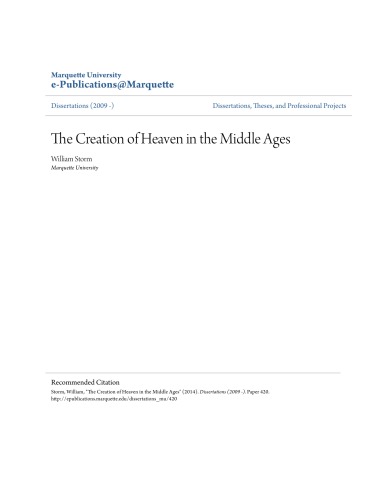Product desciption
The Creation Of Heaven In The Middle Ages Phd Thesis William Storm by William Storm instant download after payment.
My dissertation focuses on the intersection of the discourses of space and place, art, religion, and politics in poetical accounts of heaven. My study investigates how authors deploy these various traditions to create a heaven that accommodates the needs of a particular audience. Heaven is, according to Yi-Fu Tuan, a "mythical place," which cannot be located. To avoid the problems of a "mythical place," we represent that location with slightly-blurred experiential knowledge or communally-sanctioned practices. The creation of heaven, I argue, does not occur ex nihilo but through a refashioning of knowledge and practices to engage audiences with descriptions of heaven. To examine this concept, I primarily analyze the descriptions of place in Pearl and Piers Plowman, while providing discussion of Paradiso, The Vision of Tnugdal, and episodes from the writings of Hadewijch that offer competing and complementing visions. This study offers an opportunity to view heaven not as simply a consistent and monolithic feature of society but as a created site. Rather than examining heaven solely as art, or only through doctrinal concerns, heaven must be considered in terms of a variety of discourses. The layering of art, politics, religion, and space and place remind readers of the medieval religious project. God, for the medieval, was not an abstract ideal but an ever-present quality of their daily existences; as God could be seen in all facets of life, so too can heaven be seen through aspects of life that seem mundane and removed from ethereal experience. The first chapter of The Creation of Heaven in the Middle Ages outlines the problem of considering heaven as a monolithic entity. By tracing the history of heaven, the chapter demonstrates that we cannot view heaven as outside of time and place; heaven responds to the needs of particular audiences. As such, heaven cannot be considered only a religious place; heaven is a place that depends upon the engagement of multiple ideas, including theories of space and place, art history, and politics. The second chapter investigates the places of the afterlife in Pearl and Piers Plowman. While similarities exist between the two, each text offers a striking vision of the afterlife; and while a cityscape, and a besieged church and tower evoke distinct impressions of heaven, the chapter examines how each of these visions forces the reader to wonder if heaven might be a viable end. The third chapter engages in how the aesthetic choices of heaven work to create meaning within the mind of the reader. The larger goals of medieval aesthetics, embodied in stained-glass windows, reflect the projects of Pearl and Piers Plowman, namely to teach through a series of highly colored and instructive scenes. The final chapter offers a view of heaven through the political atmospheres of Ricardian England, reflecting the various choices of that monarch that impacts not only earth but also the heavenly retinue. A brief postscript closes out the dissertation that asks how these medieval visions might allow us to view the current interest of heaven, which can be seen in the popularity and success of life after death accounts.


